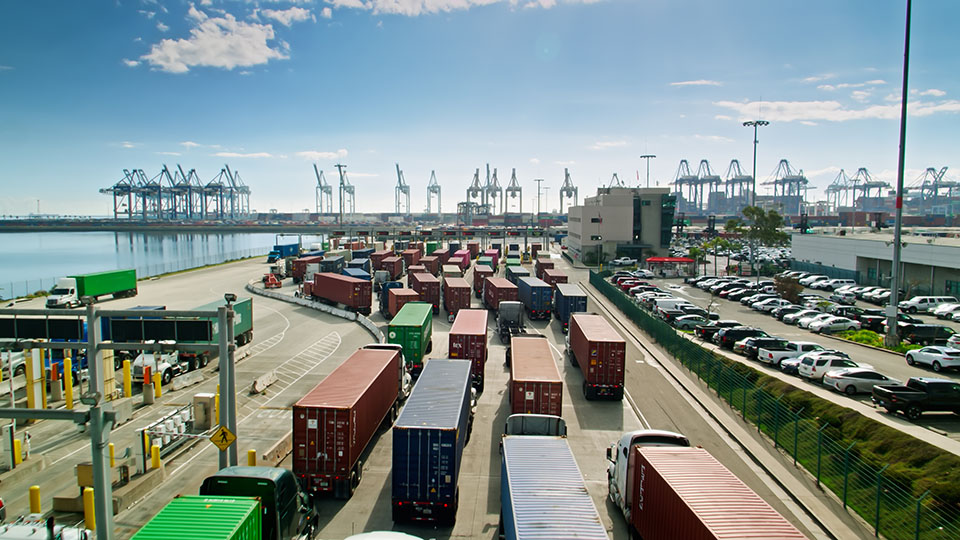Posted On October 25, 2023
Supply chains are always on the move. And as we prepare for 2024, the gears of change are turning fast. So, what can we expect on the supply chain horizon? Let’s look into the trends shaping the future of supply chain management, logistics and everything related to the intricate dance of goods from A to B.
A glimpse into 2024 supply chain trends
The industry is on the cusp of transformative changes, where automation, data-driven insights and client-specific solutions will play a pivotal role in business continuity. Let’s delve into the key trends in the coming year.
Streamlining operations with automation
Companies increasingly recognize the value and competitive advantage of automating supply chain operations in 2024. From warehouse management to inventory tracking capabilities, automation of supply chain functions is revolutionizing the industry by enhancing efficiency and reducing errors.
One noteworthy aspect is the integration of data across the supply chain. It’s not just about implementing automation in silos; it’s about creating a seamless flow of information and processes. Supply chains rely heavily on data, making it the lifeblood of their operations. By 2024, there will be a stronger focus on automating data transfer and utilizing data-driven decisions to maximize efficiency. Businesses that effectively use data will have a competitive advantage in the market.
Analytics for predictive insights
The role of predictive analytics in supply chain management is evolving from hindsight to foresight. Rather than merely analyzing past data, companies are leveraging predictive analytics to anticipate future supply chain challenges and opportunities. Predictive analytics is helping supply chain organizations make proactive decisions based on what’s likely to happen next week, not just what happened last month.
Here’s a stat to drive the point home: Companies that use predictive analytics in their supply chain management have reported anywhere from 15-30% reduction in inventory holding costs. By harnessing the combined power of data and predictive analytics, companies and retailers can fine-tune their supply chain strategies, reduce inefficiencies and be better prepared for disruptions.
Transparency in supply chain operations
Supply chain leaders say transparency is essential, especially as we approach 2024. Why? Because transparency empowers companies to make informed decisions about their supply chain. The point is not to micromanage every detail but to have a clear view of what’s happening so you can make the right business decisions.
Now, let’s talk about your customers. They’re no longer content with waiting in the dark. They want to know where their precious packages are at all times, and who can blame them? Embracing transparency isn’t just a goodwill gesture; it’s a way to build trust and stay in tune with consumer expectations. Think about Amazon’s package tracking system. You can see exactly where your order is, whether it’s out for delivery or delayed due to unforeseen circumstances. It’s reassuring, isn’t it? That’s the power of transparency in action.
The ongoing rise of circular supply chains
The ongoing rise of circular supply chains continues to shape how businesses operate, aligning with the growing focus on sustainability and responsible resource management.
Unlike the traditional linear supply chain, where products typically end up in landfills, a circular supply chain takes a different route. It’s all about bringing products back into the supply chain after their initial use, a process known as reverse logistics. This can involve refurbishing, recycling or reusing materials to reduce waste and optimize resource use.
The benefits of circular supply chains for retailers are evident. They align with the growing demand for environmental sustainability, as they reduce carbon emissions and resonate with consumers willing to pay more for sustainable products.

Route optimization for success
Efficient route and model optimization is gaining more attention than ever before. With supply chain dynamics constantly evolving, companies must adapt to changing conditions for optimal logistics. As we venture into 2024, businesses are gearing up to invest wisely in understanding the routes and models that align perfectly with their goals. Making the wrong choice could mean switching modes, which can be costly and time-consuming.
So, why should your company prioritize route and model optimization? Let’s break it down:
- Cost Savings
- Time Efficiency
- Environmental Benefits
- Improved Customer Satisfaction
- Adaptability
To ensure your route development and model optimization efforts are a resounding success:
- Analyze your current supply chain data.
- Identify bottlenecks, inefficient routes and areas where your models could use a tweak.
- Embrace technology solutions like our transportation management system, Pipeline, which can provide real-time insights.
Remember, success in route optimization is not about cutting corners but taking the right corners at the right time.
Take advantage of the latest logistics news. Subscribe to 2 Minutes Flat today.
Last mile delivery’s growing significance
The need for last-mile delivery capabilities continues to rise, especially in the age of e-commerce dominance. While not a new trend, it’s worth noting its enduring importance. As more and more people turn to e-commerce for their shopping needs, businesses need to grasp the significance of last-mile delivery and incorporate it into their strategies.
Efficient last-mile delivery is the key to keeping your customers happy. It’s about ensuring the package arrives on time and in perfect condition at their doorstep. But it’s more than customer satisfaction because it significantly impacts your bottom line. By optimizing routes and streamlining your last-mile delivery process, you can minimize costs, making your operations more profitable.
Reshoring and nearshoring: Shaping domestic supply chains
One of the primary catalysts for reshoring and nearshoring has been the series of supply chain disruptions and port issues that have reverberated globally. These disruptions have exposed the vulnerabilities of overly extended and increasingly complex global supply chains, prompting businesses to reevaluate their strategies. The result? A growing desire to bring operations closer to home.
Let’s clarify the distinction between reshoring and nearshoring. Reshoring involves relocating manufacturing or production facilities to the company’s home country. On the other hand, nearshoring entails moving operations to a nearby country or region, often with geographical proximity or a shared border. Both strategies share the common goal of reducing supply chain costs and distances.
Businesses embarking on the reshoring or nearshoring journey must meticulously assess their readiness for this transition. Here are some key factors to ponder:
- Labor pool: Does the company have access to a skilled labor force to meet its production needs? Labor availability and expertise are critical to the success of reshoring or nearshoring initiatives.
- Infrastructure: Is the necessary infrastructure in place to support the revamped supply chain? This includes transportation networks, utilities and facilities.
- Financial resources: Can the company allocate the financial resources necessary to facilitate this transition? Reshoring and nearshoring may necessitate substantial investments in facilities, technology and workforce training.
While cost savings have historically driven supply chain decisions, companies are no longer solely concerned with finding the cheapest way to source materials and produce goods. They’re looking to prioritize a consistent and uninterrupted supply of materials and keep their operations running smoothly.

Sustainability in supply chains
While sustainability isn’t a sole focus, it remains a crucial element next year. Companies are realizing that being “green” helps them to remain competitive and meet consumer expectations.
One of the smartest moves businesses can make is to form strategic partnerships with SmartWay Partners. By doing so, they can source raw materials and products that align with their sustainability goals and contribute to the development of a more ethical and responsible supply chain.
Another key area where companies are making strides is in packaging. Innovative packaging solutions that reduce waste, use recycled materials or are designed for easy recycling are gaining traction. These packaging innovations contribute to sustainability efforts and can be a marketing advantage, appealing to consumers who appreciate environmentally friendly practices.
Cybersecurity: Securing your supply chain
Supply chains are the backbone of our global economy. They’re responsible for getting the products you love from manufacturers to your doorstep, and cybersecurity remains an ongoing concern as the digitization of supply chains expands.
Cyber attacks are not isolated incidents. They’re on the rise. We’ve seen supply chains grind to a halt because of cybersecurity breaches. These disruptions cost companies millions and erode the trust of partners and customers. Investing in robust cybersecurity measures is not just a wise choice—it’s a survival strategy. Your digital infrastructure is the backbone of your supply chain, and securing it is the key to protecting your business.
Sign up for 2 Minutes Flat and get the latest news that might affect your supply chain.
Client-specific solutions: The rise of tailored solutions
One emerging trend in 2024 is the rapid rise of client-specific solutions. Businesses are moving away from the one-size-fits-all approach and embracing the idea that every client is unique. It’s another way to provide value. These solutions, like Flat World’s RVX solution, are tailored to meet unique needs, focusing on total cost reduction and minimizing damage while ensuring timely delivery. Client-specific solutions are a testament to the industry’s commitment to flexibility and customer-centric approaches.
Investing in quality people: Recruiting forward thinkers
Operational success lies in a strong team; the future is about investing in quality, forward-thinking people. First off, they bring fresh perspectives to the table. Quality people have that knack for thinking outside the box, which can lead to breakthrough ideas and creative solutions. Also, forward thinkers are adaptable. They avoid getting stuck in the past or resisting change. Instead, they embrace it.
In 2024, you can bet that the business landscape will continue to shift, and having a team that can pivot and adapt is like having a secret weapon in your arsenal. And in today’s competitive market, finding those hidden gems can make all the difference.
Resilience and risk management: Preparing for the unknown
We’ve witnessed firsthand how unpredictable events can wreak havoc on supply chains and operations, forcing companies to adapt or face dire consequences. It’s no longer enough to hope for the best; proactive preparation is the key to surviving and thriving in this uncertain world.
Diversification is a powerful strategy companies can employ to prepare for unforeseen events. By spreading out suppliers, manufacturing locations and distribution channels, businesses can avoid the risk of relying on one source too heavily. This approach minimizes the possibility of a single point of failure, which can disrupt the business’ entire supply chain.
Looking ahead: Embracing change
The supply chain and logistics industry faces challenges and opportunities as we look ahead to 2024 and beyond. Overcoming hesitancy to change is crucial. The trends outlined here are not mere predictions; they are the path forward to an improved supply chain and logistics ecosystem.
Companies that embrace these trends, adapt to new technologies and cultivate a resilient and innovative mindset will thrive in the evolving supply chain management landscape. At Flat World Global Solutions, we can help you navigate the evolving supply chain environment. Contact us to create a more efficient, transparent and sustainable supply chain management solution for the future.

